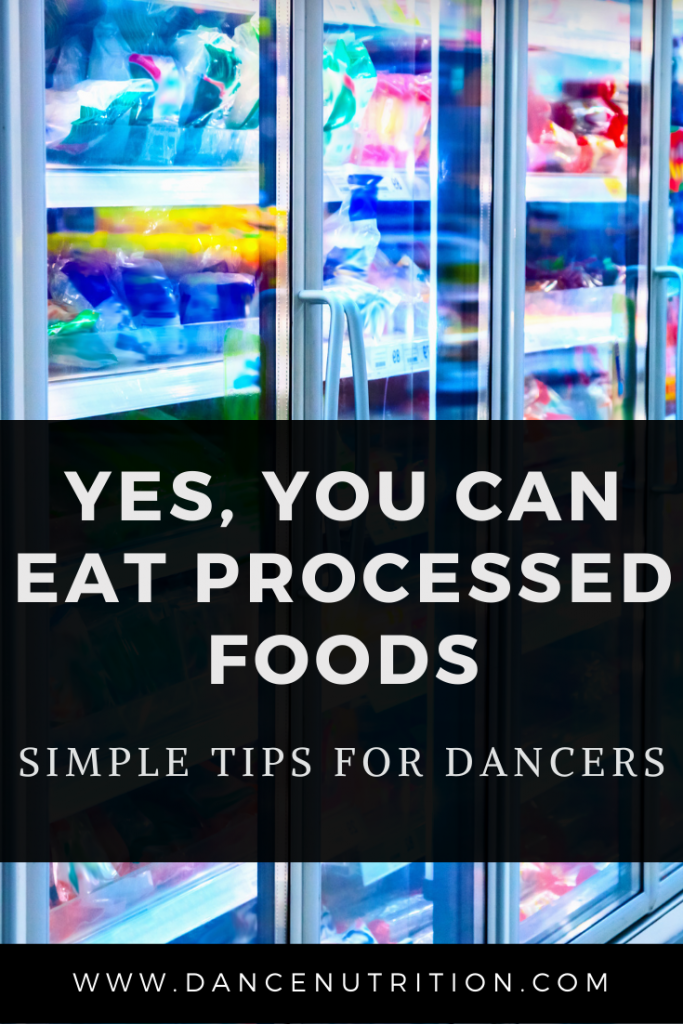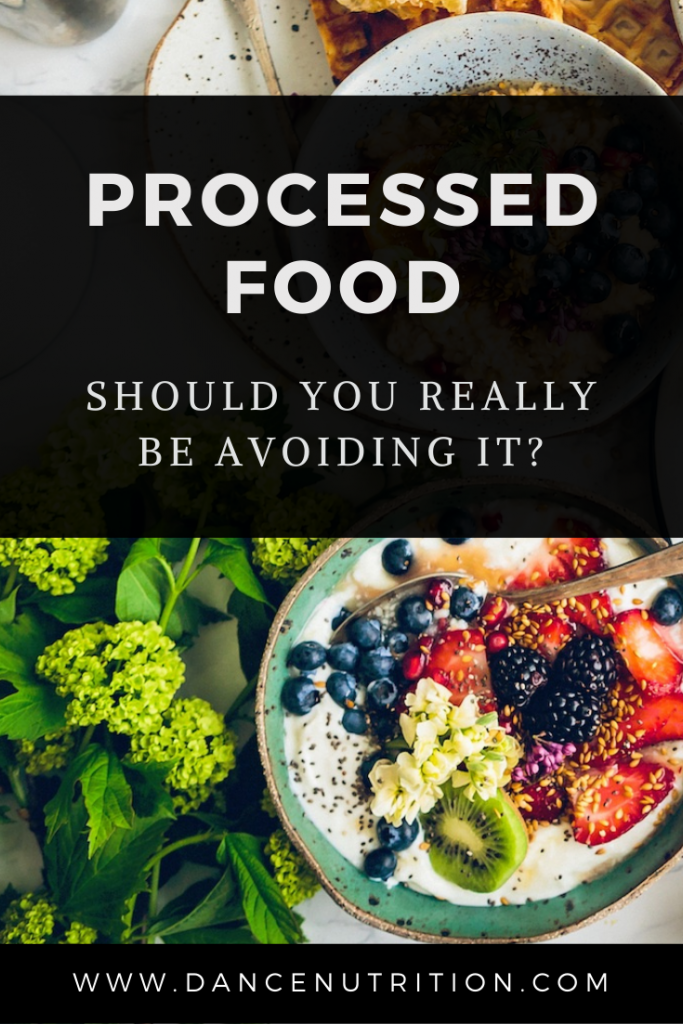Can Dancers Eat Processed Foods?
In a previous article, I explored the myths of “clean eating” and “empty calories.” Now, let’s take on another big question: Should dancers avoid processed foods?
Understanding the “Avoid Processed Foods” Mindset
Many dancers hear advice to “limit” or “cut out” processed foods, which can unintentionally divide foods into “good” and “bad” categories. While this guidance is usually well-meaning, it can lead to guilt or rigid food rules.
For dancers— who already navigate perfectionism and high expectations— this black-and-white approach to eating may create unnecessary stress around food and escalate into disordered eating.
What Does Food Processing Really Mean?
Food processing simply refers to the ways raw ingredients are transformed into forms we can eat. Sometimes this is mechanical (like chopping or cooking), and sometimes chemical (like pasteurization or fortification). Processing can actually make food safer, longer-lasting, and more nutritious. For example:
- Pasteurization protects dairy and juices from harmful bacteria.
- Fortification adds vitamins (like vitamin D) and minerals (like iron and calcium) to foods, helping reduce nutrient deficiencies across populations.
Processed foods exist on a spectrum from minimally processed (like frozen veggies, roasted nuts, pre-cut fruit) to highly or ultra processed (packaged breads, protein bars, frozen meals).
The more processed a food is, the longer it tends to last on the shelf—sometimes thanks to added sugar, sodium, or fat. These ingredients are often misunderstood, so let’s unpack them.
Processed Foods and Added Sugar
Some research connects high added sugar intake with cardiovascular disease. But if you dig deeper into this research, you’ll find that even those with the lowest risk of CVD still consume up to the recommended threshold of added sugar— around 10% or 50 grams per day on a 2,000-calorie diet. This means that even highly active dancers (who require well over 2000 calories per day) can safely consume over 50 grams of added sugar daily without compromising their health.
I’m not suggesting that you aim for this amount of sugar every day, but it’s important to understand that the occasional convenience snack or dessert is unlikely to pose any harm. For a deeper dive into sugar, check out my article here.
Interestingly, there’s conflicting research about the impacts of added sugar intake on Type 2 Diabetes risk. A recent 2020 study even associated an increase in intake with a decrease in disease risk.
Food Processing, Fat, and Sodium
Since 2018, trans fats from partially hydrogenated oils (the primary source of trans fats in packaged foods) have been banned in the U.S. Regarding sodium, the Dietary Guidelines recommend a daily intake of less than 2,300 mg. Since sodium is often added to processed foods, it’s wise to aim for 600 mg or less per meal and 100-250 mg per snack. Dancers can balance sodium by pairing packaged meals with potassium-rich foods like fruits and vegetables, or rinsing canned beans/veggies.
Are Long Ingredient Lists a Red Flag?
Many dancers worry when labels show long lists or unfamiliar terms. But “unfamiliar” doesn’t equal unsafe.
Food Additives
As defined by the World Health Organization, food additives are substances used to help preserve the safety, flavor, texture, or appearance of food. These additives are regulated and continually reviewed. Though the system has its flaws, regulatory agencies like the FDA are constantly reviewing the research and, if needed, recalling potentially dangerous foods from shelves.
Artificial vs. Natural
Although natural additives may seem like the “healthier” option, they aren’t always safer than their artificial counterparts. Research shows that natural food colorings, for example, haven’t been tested as thoroughly as synthetic ones.
Food Dyes
Research addressing concerns about Americans consuming unsafe levels of food coloring has shown that these worries are largely unfounded, with findings confirming exposure to food-color additives in the United States well below the acceptable limit. A 2016 study reached similar conclusions, affirming that even those with the highest food coloring intake are not at risk for negative health effects.
Should You Be Concerned About Red 40?
Concerns about artificial food dyes, particularly Red 40 date back to the 1970s. While some studies suggest a potential link between artificial food dyes and hyperactivity in children, these claims remain contentious. A 2007 study found that artificial colors and the preservative sodium benzoate increased hyperactivity in children, leading the European Union to require food labels identifying these additives. A number of anecdotal reports also suggest the relationship between food dyes and hyperactivity to be true, but nobody can say for certain that these dyes universally impact behavior.
In fact, in 2011, the FDA determined that there was insufficient evidence to confirm that artificial food colorings cause hyperactivity in the general population. A more recent meta-analysis also highlighted the inconclusive nature of the data. In opposition to the label requirements in the E.U., the FDA decided a label warning on food packages was unnecessary. So, what’s the take-home message?
While some children may respond well to limited food dyes to reduce symptoms of ADHD, it might only be in children with pre-existing hyperactivity. There’s not enough scientific evidence to support a broad recommendation for avoidance. The decision should be made individually, and it’s best to consult your medical doctor or a Registered Dietitian Nutritionist before removing any foods (including those with food dyes) from your diet.
How About Red Dye #3?
Red #3 (also known as erythrosine) is another food dye that gets lots of heat. Early research from the 1980s suggested a possible association between Red #3 and cancer tumor growth in rats, but this was later disproved. Despite a 2018 joint statement from the United Nations and World Health Organization deeming safe amounts of Red #3 in the current food supply, the FDA has chosen to ban the additive in 2025.
If you’re curious to learn more about food additives, I highly recommend Food Science Babe who tirelessly debunks myths surrounding ingredients like BHT (Butylated hydroxytoluene and high fructose corn syrup. Christy Harrison also debunks many fears surrounding food additives in her book, The Wellness Trap. Here are additional articles that I encourage you to read:
- Regulated Food Additives Don’t Deserve To Be Demonized
- The differences between natural and artificial colorings
- The Spread of Misinformation
Dancers and Processed foods: Key Takeaways
From a nutrition perspective, processed foods can absolutely fit into a balanced dancer’s diet. Even if medical professionals or nutrition experts advise you to steer clear of processed foods, this advice is outdated and unrealistic. For dancers —especially those with hectic schedules— processed foods can provide convenient, energy-dense options when fresh foods aren’t available.
Of course, eating mostly ultra-processed foods may not leave you feeling your best, but that doesn’t mean they need to be eliminated. What matters most is building a flexible, sustainable approach to fueling your body. For dancers, this means:
- Using processed foods when they make life easier
- Pairing them with fresh or minimally processed foods when possible
- Letting go of rigid food rules that create guilt or stress
Food doesn’t have to be perfect to support your dancing. By focusing on balance and variety, you can feel confident that both processed and fresh foods have a place in your training.




